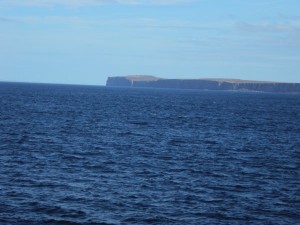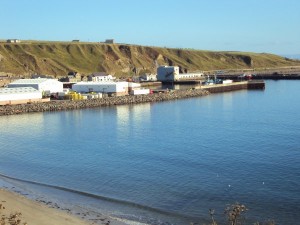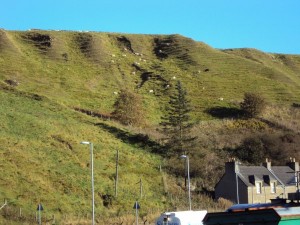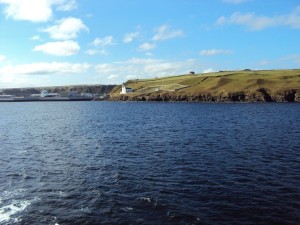
Dunnet Head ( Ceann Dùnaid ) in Caithness, Scotland. The northernmost point on the British mainland. Latitude 58°40′21″N longitude 03°22′31″W.
The sea is calm, dappled with sunlight. I’m in the dockside “Peerie Cafe,” waiting for the ferry to Stromness, in Orkney. Through the window, I can see a bleak headland that is the northernmost point of the mainland of the United Kingdom. Closer to me, sheep are grazing on a sixty degree slope — something I’ve never seen before. The timid Merino breed that I’m familiar with would never do such a thing. This is the first calm meal and coffee that I’ve had since I left Toronto. It’s been a precipitent journey.
The flight from Toronto to Gatwick was uneventful, and without delays. At Gatwick, I found out that a flight to Orkney that I could afford was out of the questions. Good prices were only for those with credit cards, a fraternity to which I don’t belong. However, I could catch a train at a scandalously low price if I were to run, not walk, the the British Rail platform, switch to the Underground at Tower Bridge, purchase the ticket at St. Pancras, and then run, not walk down the Euston Road to Euston Station in time to catch the Glasgow train. This I did, stepping into the train literally as it was closing its doors and pulling out. I had to make my way through the various higher classes to be among the commoners at the far end of the train. Keep in mind that this was all done while carrying a heavy pack full of camping equipment.
I had not slept since the previous morning, and I wasn’t going to sleep for some time. I have great difficulty sleeping sitting up, or even reclined on bus or plane seat. The Thomas Cook Airways food had been sparse and unapetizing. I was ravenous, and found myself shamelessly spending the equivalent of $9 Canadian for a package sandwich of hard to identify contents, and a cup of instant coffee. But the girl serving the train’s tuckshop was charming. There would be no possibility of anything substantial until I reached the northern tip of Scotland. Both my connections would be quick.
So I sat back to study the English countryside, which is always a pleasure. English city-scapes are depressing, because modern buildings are plunked aggressively into older neighbourhoods. Nearly identical buildings would look fine in a Canadian city, because they would look like they belonged, and there would be built with an eye to fitting in with older buildings. But here, slabs of glass and concrete are foisted on traditional neighbourhoods like an invasion of conquering alien spaceships, contemptuous of the natives.
But the English countryside is treated with more respect. It is still worthy of an Elgar or a Vaughan Williams background score. The train passes countless villages that could have hosted MidSomer Murders, and the fields are thickly populated with sheep and cattle, grazing together. The sheep apparently going for the short grass after the cattle have taken the long. The cows in the Midlands have comically large udders. Gorgeous horses frolic in stone-walled paddocks, obviously frustrated by the small spaces. Crows flock and disperse to a mysterious rhythm.
Leaving the Midlands, we passed through Wigan, which I know from George Orwell’s Road to Wigan Pier. It now seems a pleasant Lancashire town, but you can see, tucked away here and there, some grim residential streets and ruined Victorian warehouses that hint at Orwell’s account of an older, harder life.a
The Lancashire countryside shows obvious remnants of the Ice Age. There are long post-glacial eskers and tear-drop shaped drumlins scattered across the land. Further along, in Cumbria, the views upgrade to wonderful. This is the Lake District made famous by Wordsworth and the other Romantic poets. The villages here settle into the hollows between the high hills, which are dotted with sheep. It is still, however, a thickly populated, human-shaped landscsape.
Everything changes dramatically when you cross into Scotland. Unbounded forest, rather than discreet clumps of trees hemmed in by fences, walls and roads. Strings roadside houses and isolated buildings rather than focused villages. A general air of human transience in a wild landscape. In short, a Canadian feeling. And this was merely the Southern Highlands, the first line of defense against erstwhile invaders from the south… where the Romans prudently stopped.
Arriving at Glasgow Central Station, I had fifteen minutes to catch a train to Inverness, all of which was spent in a brisk walk to Glasgow Queen Station. All I can say about the train ride through the Central and Northeastern Highlands is that it is fabously, extraordinarily beautiful. The forests of spruce, pine, and birch re-inforced the the impression of Canadian-likeness.
I arrived exhausted, and fell asleep in a hostel bed at Thurso, after thirty seven hours without sleep. And now I enjoy a Scottish breakfast by the sea.



0 Comments.